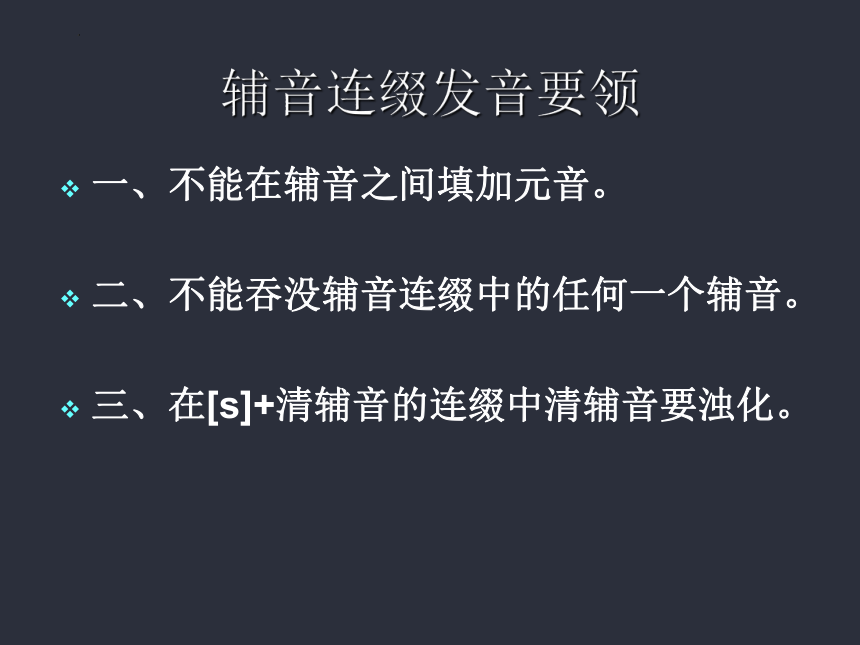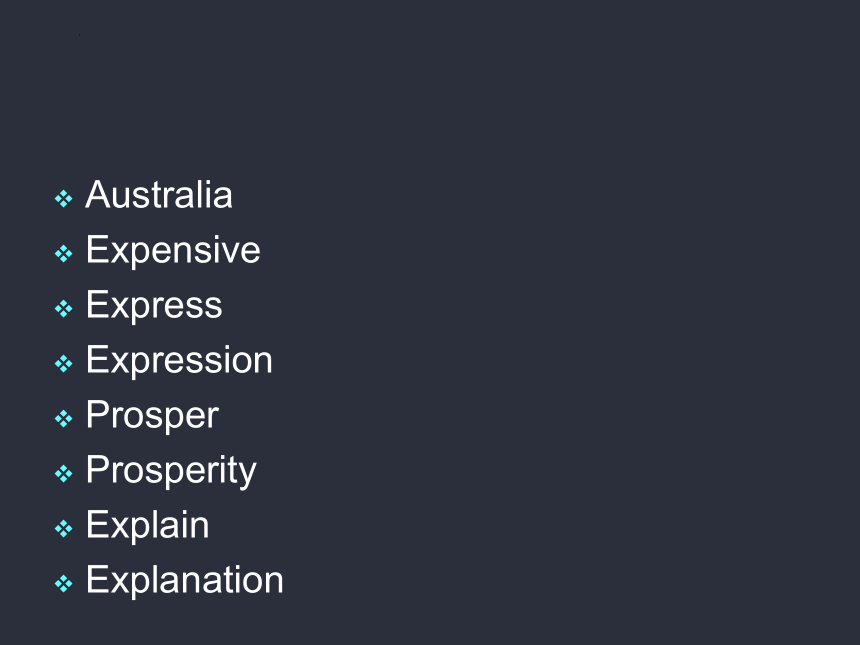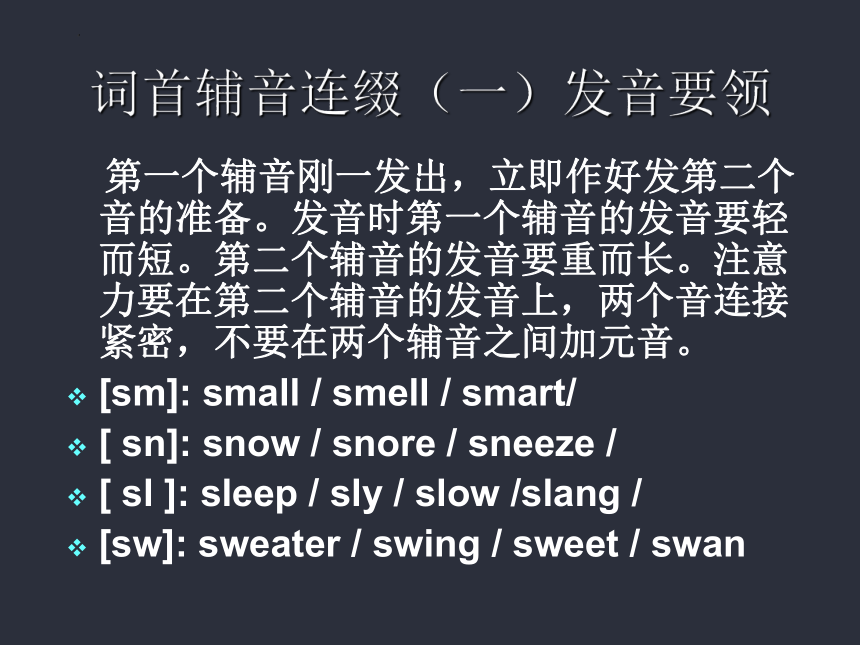2025年高考复习 广东省高考英语模仿朗读讲解 课件(共48张PPT)
文档属性
| 名称 | 2025年高考复习 广东省高考英语模仿朗读讲解 课件(共48张PPT) |  | |
| 格式 | pptx | ||
| 文件大小 | 231.5KB | ||
| 资源类型 | 教案 | ||
| 版本资源 | 外研版(2019) | ||
| 科目 | 英语 | ||
| 更新时间 | 2024-07-09 13:47:11 | ||
图片预览












文档简介
(共48张PPT)
广东高考英语模仿朗读
语音教学
辅音连缀
辅音连缀是指两个或两个以上的辅音存在于一个词中并同时出现, 构成一个不含元音的辅音群。
辅音连缀发音要领
一、不能在辅音之间填加元音。
二、不能吞没辅音连缀中的任何一个辅音。
三、在[s]+清辅音的连缀中清辅音要浊化。
[s]+清辅音连缀发音要领
[sp]: speak / sport / spring /
[st ]: stand / stick / instead / stone / stream
[sk]: school / sky / skate
Australia
Expensive
Express
Expression
Prosper
Prosperity
Explain
Explanation
词尾处的s+清辅音连缀不必浊化
如:
next /nekst /
ask /ɑ sk/
fast /fa:st/
last /la:st /
dust /d st/
词首辅音连缀(一)发音要领
第一个辅音刚一发出,立即作好发第二个音的准备。发音时第一个辅音的发音要轻而短。第二个辅音的发音要重而长。注意力要在第二个辅音的发音上,两个音连接紧密,不要在两个辅音之间加元音。
[sm]: small / smell / smart/
[ sn]: snow / snore / sneeze /
[ sl ]: sleep / sly / slow /slang /
[sw]: sweater / swing / sweet / swan
词首辅音连缀(二)发音要领
发第一个辅音的同时必须为发第二个辅音做好准备,两个音几乎是同时发音。
[ tr]: try, tree, train
[dr]: dream, draw, dragon
[pl]: play, please, plane
[pr]: press, pray, prince
[kl]: clean, clever, class
[kr]: cry, cream, crayon
/tw/: twin, twenty, twice
/kw/: quick, quite, quiet
/bl/: black, blue, blind
/br/: bread, bright, breakfast
/gl/: glass, glove, glide,
/gr/: green, great, greedy
/fl/: fly, flow, flee
/fr/: free, frog, fry
/θr/: throw, three, through
/ r/: shriek, shrewd, shrink
发音练习
试用以上方法朗读下面的单词:
train, tree, true, tray, trip, travel
drain, dream, draw, dress, drink
(读这些词时要发出清楚的/r/音, 不能把此音吞没。)
名词复数及动词过去时词尾构成的几种辅辅音连缀发音要领:
词末辅音连缀发音时须注意的问题和词首辅音连缀相同,即:
不要在两个辅音之间添加元音。
不可吞没任何一个辅音。
词尾辅音连缀需遵守
“清清浊浊”的读音规则
以清辅音结尾的名词加复数词尾及动词加第三人称单数“s”时,应发成清辅音/s/,如:
名词– caps, chips, shops, thanks, bikes, lakes
动词-- looks, asks, jumps
动词– begs, describes, calls,, comes, happens
以浊辅音结尾的名词加复数词尾及动词加第三人称单数“s”时,应发成浊辅音/z/, 如:
名词--labs, clubs, pigs, girls, teams, jeans, songs footballs, chickens, games, leaves, clothes
以清辅音/t/ 或浊辅音 /d/结尾的名词后加复数或动词后加第三人称单数形式“s”时分别读成 /ts/ 或 /dz/, 如:
名词– jackets, shirts, friends, kinds, 等。
动词-- writes, lets, spends, reads, 等。
辅音连缀 /ts/ /dz/的读音:
/ts/和汉语普通话中的c(次)相似。
/dz/和汉语普通话中的z (资)相似。
动词过去时词尾构成的辅音连缀
规则动词过去式词尾+ed亦按照“清清浊浊”的原则分别发成/ t/或/ d /。
以清辅音结尾的动词词尾+ ed发清辅音/t/, 如:asked, helped, stopped, missed, washed, touched,
以浊辅音结尾的动词词尾+ ed发成浊辅音/d/,如: robbed, begged, called, smiled moved, breathed, raised, harmed, learned, 等。
连读
不要刻意拼读两个相连的音。像音乐中的滑音一样,英语里的连读是一种自然的由一个音向另一个音滑动的过程,一带而过,中间不能有停顿,前后两音必须一气呵成。
1.辅音结尾+元音开始的连读:
在同一意群(意思上密切相关的一组词)中的两个词,前者以辅音结尾,后者以元音开头,这两个音就可以连起来读,成为“连读”。如:
He’s an American writer.
︶ ︶
School is over. China is in Asia.
︶ ︶ ︶ ︶ ︶
What is your name
︶ ︶
练习:
good idea / think of it / read it again / not at all / first of all
︶ ︶ ︶ ︶ ︶ ︶ ︶ ︶ ︶
come in / speak English / all of us / look at it / pick it up
︶ ︶ ︶ ︶ ︶ ︶ ︶ ︶
put it on / take it away / leave it alone / a bottle of ink
︶ ︶ ︶ ︶ ︶ ︶ ︶ ︶
in August / let him in / best of all / some of us / keep it up
︶ ︶ ︶ ︶ ︶ ︶ ︶ ︶ ︶
2. [r]音结尾+元音开始的连读:
相连接的两个词前一个以字母r结尾,后一个以元音开始,辅音/r/可与后面的元音连读。这种连读叫作“r连读”。例如:
far away for example
︶ ︶
There is a pair of glasses on the desk.
︶ ︶
There are about eight American novels.
︶ ︶
练习
there is / there are / your own / more over
︶ ︶ ︶ ︶
for ever / after all / later on / more or less
︶ ︶ ︶ ︶
remember it for a moment / a pair of shoes
︶ ︶ ︶
far and wide / a matter of fact
︶ ︶
不能连读的情况:
连读必须在同一意群内进行,分属两个意群中的词不能连读:
一、被逗号隔开,分属两个意群的两个词不能连读。例如:
Yesterday when he was there, I forgot to speak to him.
(逗号已把句中前后两个分句隔开,there和I分属两个意群,这两个词不能连读。)
二、虽无逗号分开,但是不属于同一意群的两个词也不能连读。
Shall we meet at the gate if it is OK
句中的gate 和 if虽无逗号分开,但是这两个词不属于同一意群,因此也不应连读。
名词、动词拼法相同的
双音节词重音
重音在前是名词,重音在后是动词:
' conduct con 'duct
' contrast con 'trast
‘ export ex 'port
' import im 'port
' increase in 'crease
' object ob 'ject
' present pre 'sent
' record re 'cord
多音节词重音
包括四个或四个以上音节的词叫作多音节词。多音节词的重音一般都在倒数第三个音节上,例如:
de mo cra cy(民主),
anni versary(周年),
im possi bility(不可能性)。
语句重音:
语句重音指的是人们在朗读连贯的语句时哪些词要重读哪些词不重读的一套规则。
语句重音的规则:
1)在语句中,所有实词要重读。
所谓实词是指在句中负有表示重要意义的词:如名词、形容词、数词、某些代词(指示代词)、疑问词、感叹词、实意动词。
名词(Nouns):
一般情况下名词在句中应重读,例如:
An elephant is an animal.
大象是一种动物。
形容词(Adjectives)
一般情况下形容词在句中应重读,例如:
Her skirt is blue and white.
她的裙子是蓝白色的。
It’s warm and sunny.
天气温暖,阳光灿烂。
数词(Numerals)
数词分为基数词和序数词,两者在句中都应重读。例如:
John is 'nine.
约翰九岁。
本句中nine是基数词,须重读。
She is in the 'forth grade.
她是四年级生。
本句中forth是序数词,须重读。
实义动词(Notional verbs)
实义动词有完整的意义, 能在句中做谓语,一般都有语句重音。例如:
Mary sings well.
玛丽歌唱得很好。
She starts her school at eight o’clock.
她八点钟上学。
副词(Adverbs)
副词在句中大都要重读。如:
He walks slowly and carefully.
他走路很缓慢,又小心翼翼。
Tom plays football very well.
汤姆足球踢得很好。
代词(Pronouns)
具有语句重音的代词:
指示代词: this, that, these,those,
反身代词: myself,yourself,himself,itself等。
例句:
He himself hurt his own foot. 是他自己 伤着了自己的脚.
Susan cooks dinner herself.
苏珊自己做晚饭。
不定代词:
具有语句重音的不定代词:
some, every, all, none, both, other, many, few, somebody, something, everybody, everything 等。
例句: Everybody is here. 每个人都在这里。
We are many, they are few.
我们人多,他们人少。
Some are red, some are blue.
有些是红的,有些 是蓝的。
疑问代词:
具有语句重音的疑问代词:
who, whom, whose, what, which, 等。
例句:
Who’s that 那是谁?
Whose bag is it 这是谁的包呢?
What would you like to eat 你想吃点什么?
Which is your jacket 哪件夹克是你的?
叹词(Interjections)
具有语句重音的叹词有:
Oh, Hey, My, Dear me, 等。
例如:
Oh, it’s snowing! 噢,下雪了。
Hey, that’s a nice shot! 嗨,那是个好球!
Dear me, he’s got a fever. 不得了了,他发烧了。
My, what a downpour! 哎呀,好大的一场雨!
人称代词:
人称代词在语句中一般不重读:如:
I, me, you, he, him, she, her, it, we, us, they, them,等。例如:
I like noodles. 我喜欢吃面条。
(不重读)
They are my friends. 他们是我的朋友。
(不重读)
We often play tennis to gether. 我们经常一起打网球。(不重读)
物主代词:
物主代词:
my, your, his, her, its, our, your, their
例:
My mother loves me a lot. 妈妈非常疼我。
(不重读)
His uncle is a famous singer. 他叔叔是个有名的歌手。
(不重读)
停顿:
为了表达和换气的需要,人们在说话或朗读时经常需要停顿。停顿不是随意的,而是有规律的与意群及气群有着十分密切的关系。停顿的时间有长、有短,由不同的标点符号将意群分开,如:由逗号、分号‘冒号分开的意群间的停顿较短,而句子末尾句号后的停顿则较长。
例如:
Lucy said:| “At the weekend, | I clean my room, | wash my clothes and do my homework.” |
停顿的练习:
A: Who’s coming tonight
B: John.
A: Just John
B: No, John and Susie.
A: No one else
B: Well, there’s Bob.
A: Alone
B: No, with Anne.
A: So that’s John and Susie and Bob and Anne. Is that it
B: Oh, and Gordon. On his own.
A: So that’s John and Susie and Bob and Anne and Gordon.
B: That’s right.
有时两个书写完全相同的句子意思却不相同。在讲话时,清楚地划分出意群可以帮助听话者分辨不同的意思。如:
1. Lucy said the teacher is clever.
Lucy said, “the teacher is clever.”
“Lucy,” said the teacher, “is clever.”
2. If you finish quickly leave the room.
If you finish, quickly leave the room.
If you finish quickly, leave the room.
语调
1. 一般疑问句用升调
例如:Have you been staying here long
Are you free tomorrow morning
Is this lesson too difficult
Did you have a good time last night
I have no idea whether he’ll come or not.
Is he still here or has he gone home already
2. 陈述句,祈使句,特殊疑问句,感叹句,一般读降调。
例如:This is my teacher.
We hope you will come again.
Come in.
Shut the door please.
Which one do you prefer
What a nice day!
Comprehensive reading
A young boy was playing with a ball in the street. He kicked it too hard, and it broke the window of a house and fell inside. A lady came to the window with the ball and shouted at the young boy, so he ran away, but he still wanted his ball back. A few minutes later he returned and knocked at the door of the house, and when the lady answered it, he said, “My father’s going to come and fix your window very soon.”
After a few more minutes a man came to the door with tools in his hand, so the lady let the boy take his ball away. When the man finished fixing the window, he said to he lady, “ That will cost you exactly ten dollars.” “ But aren’t you the father of that young boy ” the woman asked, looking surprised. “No,” he answered, equally surprised, “Aren’t you his mother ”
Thank you!
广东高考英语模仿朗读
语音教学
辅音连缀
辅音连缀是指两个或两个以上的辅音存在于一个词中并同时出现, 构成一个不含元音的辅音群。
辅音连缀发音要领
一、不能在辅音之间填加元音。
二、不能吞没辅音连缀中的任何一个辅音。
三、在[s]+清辅音的连缀中清辅音要浊化。
[s]+清辅音连缀发音要领
[sp]: speak / sport / spring /
[st ]: stand / stick / instead / stone / stream
[sk]: school / sky / skate
Australia
Expensive
Express
Expression
Prosper
Prosperity
Explain
Explanation
词尾处的s+清辅音连缀不必浊化
如:
next /nekst /
ask /ɑ sk/
fast /fa:st/
last /la:st /
dust /d st/
词首辅音连缀(一)发音要领
第一个辅音刚一发出,立即作好发第二个音的准备。发音时第一个辅音的发音要轻而短。第二个辅音的发音要重而长。注意力要在第二个辅音的发音上,两个音连接紧密,不要在两个辅音之间加元音。
[sm]: small / smell / smart/
[ sn]: snow / snore / sneeze /
[ sl ]: sleep / sly / slow /slang /
[sw]: sweater / swing / sweet / swan
词首辅音连缀(二)发音要领
发第一个辅音的同时必须为发第二个辅音做好准备,两个音几乎是同时发音。
[ tr]: try, tree, train
[dr]: dream, draw, dragon
[pl]: play, please, plane
[pr]: press, pray, prince
[kl]: clean, clever, class
[kr]: cry, cream, crayon
/tw/: twin, twenty, twice
/kw/: quick, quite, quiet
/bl/: black, blue, blind
/br/: bread, bright, breakfast
/gl/: glass, glove, glide,
/gr/: green, great, greedy
/fl/: fly, flow, flee
/fr/: free, frog, fry
/θr/: throw, three, through
/ r/: shriek, shrewd, shrink
发音练习
试用以上方法朗读下面的单词:
train, tree, true, tray, trip, travel
drain, dream, draw, dress, drink
(读这些词时要发出清楚的/r/音, 不能把此音吞没。)
名词复数及动词过去时词尾构成的几种辅辅音连缀发音要领:
词末辅音连缀发音时须注意的问题和词首辅音连缀相同,即:
不要在两个辅音之间添加元音。
不可吞没任何一个辅音。
词尾辅音连缀需遵守
“清清浊浊”的读音规则
以清辅音结尾的名词加复数词尾及动词加第三人称单数“s”时,应发成清辅音/s/,如:
名词– caps, chips, shops, thanks, bikes, lakes
动词-- looks, asks, jumps
动词– begs, describes, calls,, comes, happens
以浊辅音结尾的名词加复数词尾及动词加第三人称单数“s”时,应发成浊辅音/z/, 如:
名词--labs, clubs, pigs, girls, teams, jeans, songs footballs, chickens, games, leaves, clothes
以清辅音/t/ 或浊辅音 /d/结尾的名词后加复数或动词后加第三人称单数形式“s”时分别读成 /ts/ 或 /dz/, 如:
名词– jackets, shirts, friends, kinds, 等。
动词-- writes, lets, spends, reads, 等。
辅音连缀 /ts/ /dz/的读音:
/ts/和汉语普通话中的c(次)相似。
/dz/和汉语普通话中的z (资)相似。
动词过去时词尾构成的辅音连缀
规则动词过去式词尾+ed亦按照“清清浊浊”的原则分别发成/ t/或/ d /。
以清辅音结尾的动词词尾+ ed发清辅音/t/, 如:asked, helped, stopped, missed, washed, touched,
以浊辅音结尾的动词词尾+ ed发成浊辅音/d/,如: robbed, begged, called, smiled moved, breathed, raised, harmed, learned, 等。
连读
不要刻意拼读两个相连的音。像音乐中的滑音一样,英语里的连读是一种自然的由一个音向另一个音滑动的过程,一带而过,中间不能有停顿,前后两音必须一气呵成。
1.辅音结尾+元音开始的连读:
在同一意群(意思上密切相关的一组词)中的两个词,前者以辅音结尾,后者以元音开头,这两个音就可以连起来读,成为“连读”。如:
He’s an American writer.
︶ ︶
School is over. China is in Asia.
︶ ︶ ︶ ︶ ︶
What is your name
︶ ︶
练习:
good idea / think of it / read it again / not at all / first of all
︶ ︶ ︶ ︶ ︶ ︶ ︶ ︶ ︶
come in / speak English / all of us / look at it / pick it up
︶ ︶ ︶ ︶ ︶ ︶ ︶ ︶
put it on / take it away / leave it alone / a bottle of ink
︶ ︶ ︶ ︶ ︶ ︶ ︶ ︶
in August / let him in / best of all / some of us / keep it up
︶ ︶ ︶ ︶ ︶ ︶ ︶ ︶ ︶
2. [r]音结尾+元音开始的连读:
相连接的两个词前一个以字母r结尾,后一个以元音开始,辅音/r/可与后面的元音连读。这种连读叫作“r连读”。例如:
far away for example
︶ ︶
There is a pair of glasses on the desk.
︶ ︶
There are about eight American novels.
︶ ︶
练习
there is / there are / your own / more over
︶ ︶ ︶ ︶
for ever / after all / later on / more or less
︶ ︶ ︶ ︶
remember it for a moment / a pair of shoes
︶ ︶ ︶
far and wide / a matter of fact
︶ ︶
不能连读的情况:
连读必须在同一意群内进行,分属两个意群中的词不能连读:
一、被逗号隔开,分属两个意群的两个词不能连读。例如:
Yesterday when he was there, I forgot to speak to him.
(逗号已把句中前后两个分句隔开,there和I分属两个意群,这两个词不能连读。)
二、虽无逗号分开,但是不属于同一意群的两个词也不能连读。
Shall we meet at the gate if it is OK
句中的gate 和 if虽无逗号分开,但是这两个词不属于同一意群,因此也不应连读。
名词、动词拼法相同的
双音节词重音
重音在前是名词,重音在后是动词:
' conduct con 'duct
' contrast con 'trast
‘ export ex 'port
' import im 'port
' increase in 'crease
' object ob 'ject
' present pre 'sent
' record re 'cord
多音节词重音
包括四个或四个以上音节的词叫作多音节词。多音节词的重音一般都在倒数第三个音节上,例如:
de mo cra cy(民主),
anni versary(周年),
im possi bility(不可能性)。
语句重音:
语句重音指的是人们在朗读连贯的语句时哪些词要重读哪些词不重读的一套规则。
语句重音的规则:
1)在语句中,所有实词要重读。
所谓实词是指在句中负有表示重要意义的词:如名词、形容词、数词、某些代词(指示代词)、疑问词、感叹词、实意动词。
名词(Nouns):
一般情况下名词在句中应重读,例如:
An elephant is an animal.
大象是一种动物。
形容词(Adjectives)
一般情况下形容词在句中应重读,例如:
Her skirt is blue and white.
她的裙子是蓝白色的。
It’s warm and sunny.
天气温暖,阳光灿烂。
数词(Numerals)
数词分为基数词和序数词,两者在句中都应重读。例如:
John is 'nine.
约翰九岁。
本句中nine是基数词,须重读。
She is in the 'forth grade.
她是四年级生。
本句中forth是序数词,须重读。
实义动词(Notional verbs)
实义动词有完整的意义, 能在句中做谓语,一般都有语句重音。例如:
Mary sings well.
玛丽歌唱得很好。
She starts her school at eight o’clock.
她八点钟上学。
副词(Adverbs)
副词在句中大都要重读。如:
He walks slowly and carefully.
他走路很缓慢,又小心翼翼。
Tom plays football very well.
汤姆足球踢得很好。
代词(Pronouns)
具有语句重音的代词:
指示代词: this, that, these,those,
反身代词: myself,yourself,himself,itself等。
例句:
He himself hurt his own foot. 是他自己 伤着了自己的脚.
Susan cooks dinner herself.
苏珊自己做晚饭。
不定代词:
具有语句重音的不定代词:
some, every, all, none, both, other, many, few, somebody, something, everybody, everything 等。
例句: Everybody is here. 每个人都在这里。
We are many, they are few.
我们人多,他们人少。
Some are red, some are blue.
有些是红的,有些 是蓝的。
疑问代词:
具有语句重音的疑问代词:
who, whom, whose, what, which, 等。
例句:
Who’s that 那是谁?
Whose bag is it 这是谁的包呢?
What would you like to eat 你想吃点什么?
Which is your jacket 哪件夹克是你的?
叹词(Interjections)
具有语句重音的叹词有:
Oh, Hey, My, Dear me, 等。
例如:
Oh, it’s snowing! 噢,下雪了。
Hey, that’s a nice shot! 嗨,那是个好球!
Dear me, he’s got a fever. 不得了了,他发烧了。
My, what a downpour! 哎呀,好大的一场雨!
人称代词:
人称代词在语句中一般不重读:如:
I, me, you, he, him, she, her, it, we, us, they, them,等。例如:
I like noodles. 我喜欢吃面条。
(不重读)
They are my friends. 他们是我的朋友。
(不重读)
We often play tennis to gether. 我们经常一起打网球。(不重读)
物主代词:
物主代词:
my, your, his, her, its, our, your, their
例:
My mother loves me a lot. 妈妈非常疼我。
(不重读)
His uncle is a famous singer. 他叔叔是个有名的歌手。
(不重读)
停顿:
为了表达和换气的需要,人们在说话或朗读时经常需要停顿。停顿不是随意的,而是有规律的与意群及气群有着十分密切的关系。停顿的时间有长、有短,由不同的标点符号将意群分开,如:由逗号、分号‘冒号分开的意群间的停顿较短,而句子末尾句号后的停顿则较长。
例如:
Lucy said:| “At the weekend, | I clean my room, | wash my clothes and do my homework.” |
停顿的练习:
A: Who’s coming tonight
B: John.
A: Just John
B: No, John and Susie.
A: No one else
B: Well, there’s Bob.
A: Alone
B: No, with Anne.
A: So that’s John and Susie and Bob and Anne. Is that it
B: Oh, and Gordon. On his own.
A: So that’s John and Susie and Bob and Anne and Gordon.
B: That’s right.
有时两个书写完全相同的句子意思却不相同。在讲话时,清楚地划分出意群可以帮助听话者分辨不同的意思。如:
1. Lucy said the teacher is clever.
Lucy said, “the teacher is clever.”
“Lucy,” said the teacher, “is clever.”
2. If you finish quickly leave the room.
If you finish, quickly leave the room.
If you finish quickly, leave the room.
语调
1. 一般疑问句用升调
例如:Have you been staying here long
Are you free tomorrow morning
Is this lesson too difficult
Did you have a good time last night
I have no idea whether he’ll come or not.
Is he still here or has he gone home already
2. 陈述句,祈使句,特殊疑问句,感叹句,一般读降调。
例如:This is my teacher.
We hope you will come again.
Come in.
Shut the door please.
Which one do you prefer
What a nice day!
Comprehensive reading
A young boy was playing with a ball in the street. He kicked it too hard, and it broke the window of a house and fell inside. A lady came to the window with the ball and shouted at the young boy, so he ran away, but he still wanted his ball back. A few minutes later he returned and knocked at the door of the house, and when the lady answered it, he said, “My father’s going to come and fix your window very soon.”
After a few more minutes a man came to the door with tools in his hand, so the lady let the boy take his ball away. When the man finished fixing the window, he said to he lady, “ That will cost you exactly ten dollars.” “ But aren’t you the father of that young boy ” the woman asked, looking surprised. “No,” he answered, equally surprised, “Aren’t you his mother ”
Thank you!
